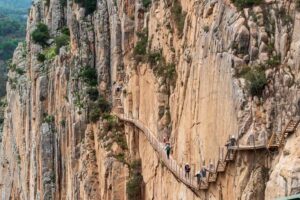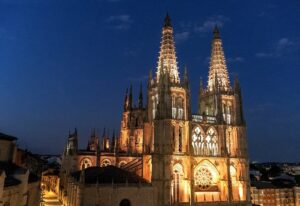
The Camino Sanabrés is a variant of the Jacobean routes in the southern Iberian Peninsula, which has become very popular in recent years among pilgrims, especially following the arrival of the high-speed AVE train to the city of Ourense, a route operated by our Travel Agency. It was originally used as royal cattle trails and for merchants, which is why hospitals, inns, temples, and monasteries were built along this route.
Therefore, if you want to undertake the organised Camino de Santiago journey, the Camino Sanabrés or Camino Mozárabe is an ideal alternative. Particularly because of its historical monuments and ancient Roman roads. Along this route, you’ll encounter buildings of great historical and artistic value, offering you a chance to learn about some of the most significant events of the time.
To help you get to know this Jacobean route a bit better, we’ll describe in detail the most important monuments you can visit and enjoy on the Camino Sanabrés. Pay attention!
Índice de contenidos
Historical Sites on the Camino Sanabrés
This route begins in Granja de Moreruela (Zamora), passes through the province of Ourense, and reaches Santiago. It is a journey that maintains the Jacobean essence and is loved by visitors.
Throughout the entire route, you’ll be able to enjoy the majesty of the imposing Esla River, ancient monasteries, picturesque villages with natural attractions, churches, and statues erected in the Plaza Mayor. The journey also offers highly appealing museums and a wide variety of temples typical of the 9th and 13th centuries.
On this route, you’ll feel as if you’re part of history and experience the spirituality of the place in a profound way.
Most Important Monuments on the Camino Sanabrés
The complete Camino Sanabrés route begins in the village of Granja de Moreruela and consists of 15 stages leading to Santiago. Along this route, you’ll encounter the most important historical and artistic monuments. Although it’s not as popular as the Camino from Sarria to Santiago, we are confident you will love it.
Below, we’ll highlight the five most important monuments you can find across the various stages of the Camino:
Ruins of the Monastery of Santa María de Moreruela
This is a Cistercian monastery of historical and cultural interest, of which only the ruins remain. These ruins were declared a National Monument in 1931. It is one of the most important monasteries in the area and received favours and donations from the Kings of Castile, León, and Portugal.
Furthermore, it offers the opportunity to take a tour from the entrance to different parts of the cloister of the guesthouse. You can see the remains of what was once the apothecary and the infirmary.
Additionally, you can explore the regular cloister built in the 12th century, which is square in shape and still preserves traces of the arcades on the floor. The pavement surface is original. You can also see a water conduit and the area where the kitchen and dining room were located.
During the tour, you can enjoy the chapter house, the armory with two side niches and the chancel. It also includes different rooms such as the sacristy, the parlour, and the monk’s hall.
Romanesque Church of Santa Marta de Tera
This church is located on the banks of the Tera River and constitutes one of the historical and artistic gems of the cultural heritage of the Zamora province. Its structure has a floor plan that perfectly forms the shape of a Latin cross. Its chancel is square and lacks a semicircular apse due to its Visigothic style influence.
A notable feature is that it was built with stone blocks and has a decorative eaves featuring Jaqués or checkered masonry. This temple is an important Jacobean site as it marks the beginning and end of one of the stages of the Camino Sanabrés to Santiago.
Moreover, here you can find the oldest representation of the Pilgrim Apostle Santiago, which is located on the west side of the southern portal of the church.
Santuario de Nuestra Señora de la Carballeda
If you decide to take the Camino Sanabrés, you can enjoy this attractive tower over 20 metres tall, made of ashlar stone. This is the Santuario de Nuestra Señora de la Carballeda. It is a Romanesque structure that offers a warm spiritual experience.
The sanctuary has a three-nave floor plan separated by pointed arches and semi-columns attached to the supporting pillars. Additionally, the ceiling creates a perfect balance with the dome and star-vaulted ceiling.
In this sanctuary, you’ll find the statue of the Virgin of the Carballeda, with a green and white mantle, crowned in silver and holding the child. This makes it a highly admired piece of art.
Colegiata de Santa María La Real
This is a very old 13th-century building in the Compostela Romanesque style. Its construction was commissioned by King Ferdinand II of León. The funeral slabs and tombs, as well as its large medicinal herb garden, similar to those from the Middle Ages, are also highly attractive.
This building has an articulated Christ, shown either as a reclining or crucified figure. Additionally, the cloister is from the 16th century, and the walls and interior columns are noticeably tilted towards the lateral naves, providing pilgrims with a unique sense of instability.
The Colegiata also offers a large collection of archaeological and liturgical pieces, such as the 12th-century baptismal font.
Monastery of San Martín de Castañeda
This is a historical and artistic monastery in Romanesque style, rebuilt on several occasions, inspired by the cathedral of Zamora. It also features a southern wall from the abbey church. It is the only completely preserved temple from the Cistercian monasteries.
This historic building has three naves divided into four sections with three entrances: one in the western hostel and two in the nave of the epistle. It stands out for being built with granite and slate stone. The other monastic dependencies were repurposed as quarries for building houses and structures in the nearby village.
You can admire its perfect architecture, particularly its attractive chancel, formed by three staggered semicircular apses. This structure rises on a podium that articulates the hemicycles and divides them into sections. The space offers clean lines and evident ornamental austerity.









